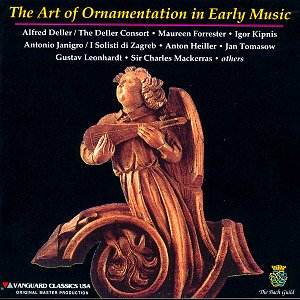Early and baroque music make ample use of ornamentation,
or the addition of notes to a melody to change and decorate it. All
types of music from these periods use ornamentation, and it is, in most
cases, up to the performer to decide how to play it. In many cases,
music with repeats - the same section played twice, as is often the
case with baroque music - is played in such a manner that the repeat
is an ornamented version of the first section. There are many ways to
ornament music, and the latitude is wide - from subtle, occasional ornamentation,
as is often heard with Bach’s music, to more complex ornaments such
as that of the French school of harpsichord music.
This two-CD set, recorded in 1966, is an attempt to
show listeners the ins and outs of ornamentation. By the presentation
of the same pieces of music in two forms - a simple form, followed by
an ornamented form - listeners can understand just how music is ornamented,
and can hear a wide variety of ornamental styles.
The music on this set ranges from renaissance vocal
music, by composers from the 15th and 16th centuries, to baroque and
late baroque music, stopping with Gluck. Some of the most famous composers
are featured here: Couperin, Vivaldi, Handel, Telemann, Corelli, but
absent are some of the staples of the baroque period, such as Bach,
Buxtehude, and Purcell. Nevertheless, the reason to buy this set is
more for its pedagogical value than the music itself.
One of the most striking examples of ornamentation
is the Menuet by Couperin. In its basic, "unornamented" form,
it already contains a great deal of ornaments. The second form shows
how ornamentation can truly be improvisation, as the melody is deconstructed
and reconstructed. This short piece, at just over one minute, is a lesson
on its own on the art of ornamentation. Some of the vocal music shows
how complex ornaments can be. The Handel aria Lascia ch’io pianga is
a good example of this, as soprano Annelise Hückel takes this simple
melody and changes it totally in tone and effect.
This is not a disc to buy to listen to often, nor are
its performances memorable. But it does give insight into the art of
ornamentation and will help any lover of early and baroque music better
understand this essential component that gives the music a unique character.
Kirk McElhearn
